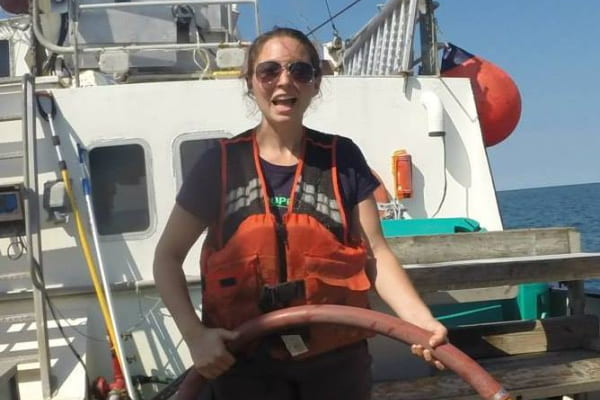Emily Markowitz (BS, 2015)

In the Fall of 2015, Emily Markowitz was a senior graduating with a major Marine Sciences with minors in Coastal Environmental Science, Geospatial Science and Theatre. She was accepted into the Accelerated BS/MS degree program with Dr. Janet Nye in her Fisheries Ecology Lab. Emilywas very excited to conducting real, meaningful research and contribute to the scientific community.
Emily had a variety of experiences during her time at Stony Brook. She received the Stony Brook Mote Marine Lab Scholarship during the summer of 2015 and spent 10 weeks doing research in a snook release project at the Laboratory’s Aquaculture Park in Sarasota, Florida. She served as the president of the Stony Brook Undergraduate Marine Science Club for two years, and lead the group on activities that included trawling and whale watching trips out of Southampton, seal walks, and volunteering with various organizations such as Coastal Steward and Cornell Cooperative Extension’s Marine Meadow Restoration Program. These organizations have also been included at events like Earthstock. The club also participated in the Pew Charitable Trusts’ Bluefin Tuna Initiative and won a trip to meet with Pew and the head of NOAA fisheries, Sam Raunch, to talk about the Pew initiative. The club continues to provide our community with talks and public screenings of documentaries. For many of the students in the club, these events are their introduction to research and conservation issues in Marine Science. In 2014, Emily also headed a major outreach program in which Marine Science Club members gave presentations (with valuable assistance from Dr. Larry Swanson) to two local middle schools about marine pollution and how it affects Long Island’s local biodiversity.
Emily’s experiences as a crew member on the R/V Seawolf, including trips to assist the New Jersey DEP in doing trawls and collecting data for their quarterly stock assessment program allowed her to see, first-hand, the distribution and density of our coastal waters and how a program like this works.
Emily’s undergraduate research experiences have allowed her in a number of labs on campus, including those of Drs. Janet Nye, Brad Peterson, and Joe Warren. While each lab pursued different questions and had different approaches and specialties, each experience provided her with greater insight into laboratory structure and methodology. While studying abroad in New Zealand, she also worked for Dr. Steven Wing in his lab. Wing is exploring isotope markers in fish populations.
Everything that Emily learned at Stony Brook and all of the extracurricular activities she participated in made her a better candidate for the BS/MS accelerated program and better prepared to write her thesis, which focused on the development of species distribution models that combined fisheries-independent bottom trawl survey data with oceanographic models to predict suitable habitat and distributional shifts.
After graduation, Emily was a contractor within the Office of Science and Technology (OST) in Silver Spring, MD where she primarily worked with the Economics and Social Analysis Division to provide statistical and data visualization expertise. As a John A. Knauss Fellow in the same office, she facilitated protected species science at the national level with researchers in fisheries and marine mammal sciences. In each of her positions, Emily has also been actively involved in teaching and promoting the use of open science and R programming across NOAA Fisheries. She is an Openscapes mentor, as well as a co-organizer of the NMFS R Users Group. Today, Emily is a Research Fisheries Biologist in NOAA Fisheries Alaska Fisheries Science Center’s (AFSC) Bering Sea survey team in Seattle, WA. There, she ventures on research surveys, conducts statistical analyses, and develops data products to better understand the marine ecosystems of Alaska.
Emily encourages students to join a club and meet people and get involved with the programs and organizations that are around campus and off campus! She says “that’s how you make opportunities, and build your experience! The way I got my first opportunity in a lab was by asking. Seek out professors and find out what they’re doing. Pick out what interests you and offer your services. Learn to code! Take classes in R or Matlab and learn ArcGIS. These programs make it possible to do the analysis that makes research relevant.”
